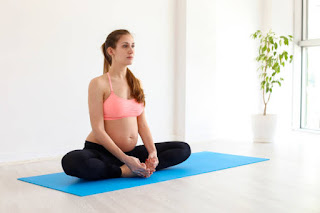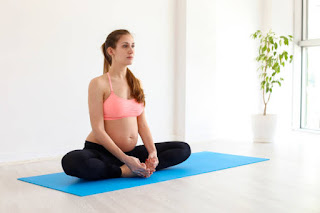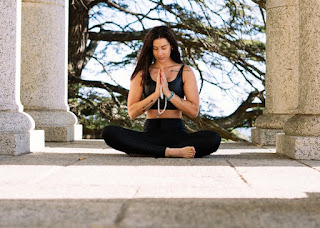Nurturing Your Body: Yoga for the First Trimester
First Trimester Yoga Routines and Pose Suggestions

With safety precautions in mind and an understanding of yoga’s benefits, the next question is how to practice yoga in the first trimester. The guiding principles are to keep it gentle, listen to your body’s cues, and adapt the practice to how you feel on any given day. Below are some suggestions for a first-trimester yoga routine, including recommended poses and modifications. These routines are suitable for beginners and can be adjusted for different fitness levels or symptom days.

Child’s Pose (Balasana) is a gentle resting posture often used in prenatal yoga. With knees apart and a support under the forehead, it can ease nausea and fatigue by calming the nervous system. This pose can be used anytime you need a break during practice.
Begin with Breathing and Centering
Start each session by connecting with your breath. You might sit comfortably (on a cushion if needed) and practice slow deep breaths or simple prenatal breathing techniques. This helps oxygenate your body and relax your mind. Gentle breathwork can also mitigate nausea or anxiety. If morning sickness is strong, sometimes just a short meditation or breathing practice is enough until you feel better. On days when you’re extremely fatigued, you can even skip the physical poses and do a guided yoga nidra (yogic sleep meditation) or practice soothing mantras/mudras instead. The key is to honor your energy level: rest when needed, and use yoga’s mental exercises when your body needs a break.
Gentle Warm-Up Movements
It’s important to warm up muscles and lubricate joints, especially as pregnancy hormones might make joints a bit unstable. Cat-Cow stretches (on hands and knees, arching and rounding the back) are an excellent first-trimester warm-up. This movement increases spinal flexibility and can relieve back tension. It’s also helpful for nausea – the all-fours position and rhythmic motion can sometimes ease queasiness. Another good warm-up is neck and shoulder rolls to release upper-body stiffness. Move slowly and avoid any extreme ranges of motion. These gentle exercises prepare your body for more active poses and reduce the chance of injury.
Standing Poses for Strength and Balance
Incorporate some basic standing poses to build strength, improve circulation, and counteract the joint-loosening effects of relaxing. For example, Vrksasana (Tree Pose) is a simple balancing pose where you stand on one leg (with the other foot placed on your ankle or thigh) and bring hands together at your heart or overhead. Tree Pose helps improve your balance and posture, and it strengthens the legs and core without straining the body. Do it near a wall or chair for support, especially if you feel wobbly.
You can also practice modified Warrior I or II poses or a supported side angle pose to gently work your leg muscles and open the hips. Goddess Pose (Utkata Konasana), a wide-legged squat, is another first-trimester-friendly stance, it strengthens the thighs and glutes and engages the pelvic floor muscles when done with proper form. In goddess, you stand with feet wide and knees bent (like a sumo squat). This can be intense, so only lower into the squat as far as comfortable, and use a wall for balance if needed. Remember to keep breathing steadily through each pose; if you can’t breathe smoothly, come out of the posture and rest.

A wide-legged squat, often called Goddess Pose, is a strength-building posture suitable for early pregnancy. This pose helps tone the legs and pelvic floor. In the first trimester, you can perform goddess pose as shown (with arms in a receptive position) to build stability, just go only as deep as is comfortable and use support if needed.
Hip Openers and Seated Poses
Early pregnancy is a great time to gently open the hips and work on flexibility, which can aid comfort in later months. Butterfly Pose (Baddha Konasana) – sitting with soles of the feet together and knees dropped outward – is a classic prenatal hip opener. It stretches the inner thighs and groin; you can sit on a folded blanket and not push the knees too far down, just let gravity do the work.
Malasana (Garland Pose) is a yoga squat where you squat deeply with feet slightly apart; in the first trimester, you might be able to do this with heels on the floor or on a folded blanket. Malasana helps stretch the lower back and opens the pelvis; it also subtly strengthens the pelvic floor by engaging those muscles to support the pose.
If you’re prone to prolapse or it feels too intense, skip the deep squat or do a higher version with support under your hips. Many women find these hip-opening poses relieve tension in the pelvic region. They also prepare your hips for the expansion that comes later. Always move slowly into hip stretches and avoid any sharp pain in the pelvic area.
Mild Inversions and Downward Dog
Inversions (upside-down poses) are largely contraindicated, but Downward Facing Dog is a mild inversion that is generally considered safe throughout pregnancy for most women. Downward dog stretches the hamstrings, calves, and spine, and can help with shoulder strength. If you were doing down-dog regularly before pregnancy, you can likely continue it in first trimester. However, listen to your body, some women find that having the head lower than the heart makes them dizzy or nauseous in early pregnancy.
If Downward Dog makes you nauseous, skip it or shorten the duration, and try an alternative like Puppy Pose (similar shape but with knees on the ground) or simply return to Child’s Pose for a break. Always avoid any inversion that you’re not fully comfortable with. Now is not the time to learn headstands, for example. But gentle inversion-like poses such as lying on the floor with legs up the wall can be relaxing and improve circulation, so long as they don’t make you lightheaded.

Relaxation and Cool Down
Each yoga session should end with a period of relaxation to integrate the benefits. In the first trimester, you can still comfortably lie flat on your back for Savasana (Corpse Pose). Take advantage of this before your belly makes it difficult – lying flat for a few minutes is safe in early pregnancy. You might lie on your back with knees bent and feet on the floor (constructive rest position) or put a pillow under your knees for comfort. Another wonderful restorative pose is
Supported Supta Baddha Konasana (Reclined Bound Angle Pose)
Lie on your back propped up on a cushion or incline, with the soles of your feet together and knees gently opened to the sides, supported by pillows or blocks under the thighs. This pose opens the hips and chest and has a calming effect to relieve stress and fatigue. Cover yourself with a blanket, close your eyes, and breathe deeply. This quiet final pose helps activate your body’s relaxation response. Focus on slow abdominal breathing and let go of any remaining tension. Finishing your practice with a relaxation or short meditation will leave you feeling recharged and peaceful.
Adapting to Daily Symptoms
It bears repeating that your yoga routine in the first trimester should be flexible and adaptable to how you feel on any given day. If you wake up very nauseated, you might do only breathing exercises and a gentle child’s pose until the nausea passes. If you’re feeling energetic, you might do a slightly longer session with more standing poses. Fatigue is very common in the first trimester; on days when fatigue is overwhelming, consider a shorter yoga session or one focused on restorative poses.
Using props can turn many poses into restful, supported versions. For example, if even gentle forward bends make you dizzy, try doing them semi-reclined or with ample cushions. Yoga’s benefit is that it’s easily adjustable – even 10 minutes of prenatal yoga stretching and breathing can be helpful. Always come out of a pose slowly, especially if you’ve been lying down or head-down, to avoid sudden drops in blood pressure or dizziness. And maintain a “conversation level” intensity, you should be able to breathe and even talk throughout your practice (this ensures you’re not overexerting).
Finally, enjoy the experience of prenatal yoga. It’s not only a form of exercise but also a time to bond with your changing body and growing baby. Many women use this time to set positive intentions or practice mindfulness about the new life chapter ahead. If you join a prenatal yoga class (in person or online), it can also provide a sense of community and support, which is emotionally uplifting. Remember to follow the safety guidelines, avoid the contraindicated moves, stay hydrated, and so on, but don’t be afraid to move and breathe.
Yoga in the first trimester, done prudently, can be a rewarding practice that nurtures both body and mind. As one study concluded, yoga is “safe, feasible and acceptable” in pregnancy and may even be more beneficial than standard prenatal exercise for both physical and mental health. By starting gentle yoga now, you’re investing in your well-being for the months to come.

For Further Reading






